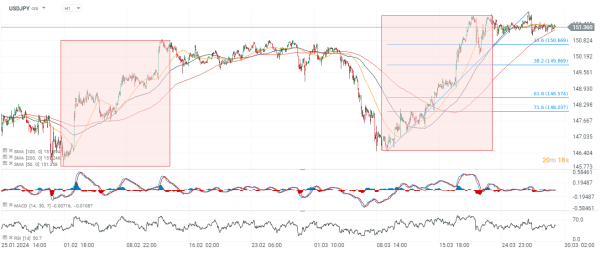Chart of the day - USDJPY (29.03.2024)
Currency pairs linked to the Japanese yen may experience spikes in volatility, in the near term. Japan's Finance Minister Suzuki stressed that currency market movements are exaggerated and are purely speculative. Moreover, he did not rule out the need for further interventions in the yen.
- Thus, traders must be mindful of the bank's possible intervention and may view bullish positioning on USDJPY as potentially riskier. We learned a number of data from Japan's economy today, and although industrial production, home sales or inflation itself turned out to be lower than forecast, consumption data indicates that Japanese consumers are doing better:
- Japan's industrial production fell -3.4% y/y vs. -1.5% previously. Building permits in Japan fell -8.2% y/y vs. -5.45% forecast and -7.5% previously. Core inflation in the Tokyo region was 2.4% vs. 2.5% previously, in line with forecasts
- Retail sales in February turned out to be quite a bit higher, rising 4.6% y/y. An increase of 2.8% was expected, versus 2.1% previously. On a monthly basis, sales rose 1.5% vs. 0.6% forecast and 0.8% previously. Supermarket sales rose 7.2% vs. 3.3% previously
USDJPY
Looking at the USDJPY chart, we see that the pair has settled below the SMA50 and SMA100 averages (yellow and black lines). The key support line now is the SMA200 (red line), which runs around 151.2. A potential drop below it could lead, to a test of the levels of 150.7 where the 23.6 Fibonacci retracement of the last upward wave is located. At the same time, it would be a test of the 1:1 upward correction structure.
Source: xStation5